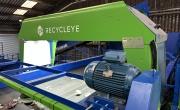Options for evolution of producer responsibility set out in PackFlow 2025 report
A study offering four models for the evolution of the UK’s producer responsibility system was launched by compliance scheme Valpak at the Resourcing the Future Conference yesterday (27 June).
The report, commissioned by Valpak and delivered independently by Valpak Consulting after 12 months of research, sought to review producer responsibly systems from across Europe and analyse their performance and how they could be used to inform the development of the UK’s system, as new proposed targets for packaging recycling put UK compliance in doubt.
At present, the UK works by assigning material levy rates to packaging, which are paid by producers through the purchasing of variably priced packaging recovery notes (PRNs).

Valpak predicts that 2025 targets for paper and cardboard, metals and glass will be met with ‘minimum intervention’, while aluminium will require a larger step, but one that is believed to be achiveable with the addition of material recovered from incinerator bottom ash (IBA). Plastic is likely to need more support, and each material, barring paper and card, will need ‘additional intervention’ to meet the proposed 2030 targets.
With assistance from Belgium-based consultancy Verde Consulting, the study looked at producer responsibility systems from Belgium, Netherlands, Spain, Germany, Italy and France, which all operate different systems. However, in contrast to the UK, material levy rates in each of the countries are not market-based, and are instead set annually and paid against material placed on the market.
The nations studied use a mix of systems that operate through a single scheme (Eco-Emballages in France, Conai in Italy, Nedvang in Netherlands), complementary schemes (Belgium and Spain) and competitive schemes (UK and Germany).
Four models
The study developed four models incorporating elements from the six nations that could be used to, to varying degrees, drive up packaging recycling, improve material quality and meet circular economy targets.

Launching the report and explaining the four models at the Resourcing the Future conference, Valpak Chief Executive Steve Gough said: “One is to stay as we are. The next is an enhanced UK system, nationally managed with a flat fee for de minimis. The next suggestion is building on number two – including that we also levy an extra amount on producers that put materials on the market which are harder to meet the target. This is a non-competitive issue, with bonuses for recyclability and recycled content. Model four, is full net costs – producers have to cover the whole process.”
The report recognises that an EPR system should not be considered in isolation of other policies and suggests a number of supporting measures that could be put in place to assist and encourage the system based on experience in other European countries.
Gough added in a statement accompanying the report: “We believe that although there is clearly a lot of uncertainty going forward, this reports goes some way to providing some clarity and thoughts around what could be achieved and how it could operate in a very practical approach which could help deliver future challenges in a cost effective and fair way for all going forwards.
“We hope people read the report, consider its findings and we will continue to engage with stakeholders to take their views into consideration.”
The work has been supported and advised by input from a PackFlow 2025 Steering Group made up of key producers and retailers, trade associations, material organisations, regulators, and Government.
The full PackFlow 2025 report can be read and downloaded on Valpak’s website.







